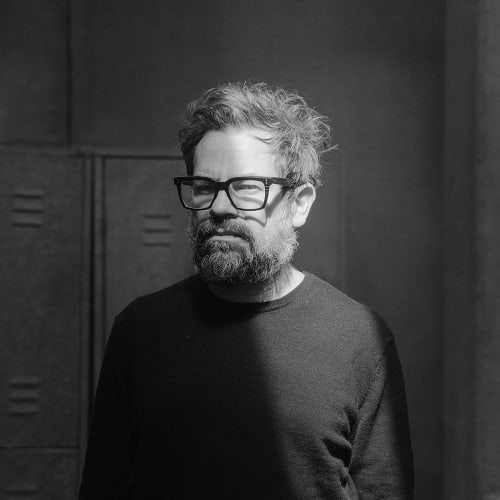Pedro Reyes (Mexico City, Mexico, 1972) is a multidisciplinary artist whose practice spans sculpture, architecture, theater, psychology, and activism as strategies to provoke social transformation. Although trained as an architect, he primarily defines himself as a sculptor, even as his artistic output defies categorization. He is widely recognized for projects that address urgent issues such as gun violence, democracy, the environment, and mental health—always with a propositional, optimistic, and deeply inventive approach.
Reyes believes that art must offer alternatives and visions of the future, even utopian ones. For him, humor is a powerful tool for disarming resistance and engaging with difficult topics, serving as a bridge between critique and imagination. His work steers away from lament and sterile denunciation, proposing viable paths for structural change. His pieces often activate participation and occupy public space as a way of democratizing access to art. He has contributed to curatorial projects, publications, and institutional initiatives, always with the aim of expanding the boundaries of art and its role in society.
Among the recurring strategies in his work is a commitment to creating “creative valves” for dealing with complex social issues such as violence. Through the symbolic and material transformation of objects associated with destruction into instruments of construction, dialogue, and expression, the artist proposes poetic and concrete ways of re-signifying conflict, evoking possibilities for repair and change.
Solo exhibitions include Amnesia Atómica, Museo Anahuacalli, Mexico City (2024); Direct Action, SITE Santa Fe, New Mexico (2023); Museum of Contemporary Art of Monterrey, Monterrey (2022); Escultura Social, MARCO, Mexico (2022); Pedro Reyes, Luisa Strina, São Paulo (2021); Return to Sender, Museum Tinguely, Basel (2020); Glyptotek, Lisson Gallery, London (2018); Recent Works, Luisa Strina, São Paulo (2017); Doomocracy, Creative Time, New York (2016); Domingo Salvaje, La Tallera/SAPS, Cuernavaca (2016); For Future Reference, Dallas Contemporary (2016); pUN: The People’s United Nations, Hammer Museum, Los Angeles (2015); Sanatorium, The Power Plant, Toronto (2014).
Group exhibitions include: Macao International Art Biennale (2025); The Paradoxes of Internationalism (As Narrated by the Museo Tamayo Collection): Part II, Museo Tamayo, Mexico City (2024); Museo de Arte Moderno, Mexico City (2023); Museo Jumex, Mexico City (2021); Jing’an International Sculpture Project, Shanghai (2020); Think Twice, SCAD, Georgia (2019); Half the Picture: A Feminist Look at the Collection, Brooklyn Museum of Art, New York (2018); Hors Pistes, Centre Pompidou, Málaga/Paris (2016); Transformers, MAXXI Museum, Rome (2015); Who Interprets the World?, 21st Century Museum of Contemporary Art, Kanazawa (2015); Station to Station, Barbican Centre, London (2015); El Teatro del Mundo, Museo Tamayo, Mexico City (2014); In the Spirit of Utopia, Whitechapel Gallery, London (2013); 12th Sharjah Biennial (2013); Liverpool Biennial (2012); Gwangju Biennial (2012); dOCUMENTA(13), Kassel (2012); Istanbul Biennial (2012).
He was the inaugural Dasha Zhukova Distinguished Visiting Artist at the MIT Center for Art, Science & Technology (CAST) at the Massachusetts Institute of Technology in 2016.
His work is part of numerous public and private collections, including: 21st Century Museum of Contemporary Art, Kanazawa; Brooklyn Museum, New York; Colección Jumex, Mexico City; ICA Institute of Contemporary Art, Miami; Kadist Art Foundation, San Francisco; Bronx Museum, New York; Carnegie Museum, Pittsburgh; La Tallera/SAPS, Cuernavaca; MAXXI, Rome; MAC/VAL, Vitry-sur-Seine; Museo Rufino Tamayo, Mexico City; MUAC, Mexico City; MFA, Boston; Walker Art Center, Minneapolis.
